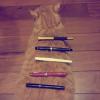Search the Community
Showing results for tags 'iron gall ink'.
-
Y'know, it's kind of hard to live up the quality of reviews by folks like LizEF or Yazeh or the very much lamented late Sandy1. Years back, FPN folks like me would print off a sample sheet on a laserjet - there were several formats here on FPN - write a few lines, maybe use two or three nibs, flick some water on an inked grid, and Hey, presto! , we had a review to post. Now we have paper chromatography, a score of different papers, scads of pens and nibs, videos, microscopic measured photos, and some amazing artwork. Sincere kudos to all concerned, but I'm perhaps just not up to that level of review. But it is possible to describe some of the experiences we get with inks. Some of these experiences don't translate (yet) into posts on FPN. Short of the John Waters movies with scratch-n-sniff cards, we can't recreate odours of inks for people reading online. The exact feel of a pen nib on paper with an ink doesn't come up in a display, unless the video records a hideous scraping noise coupled with fulsome curses from the writer. We generally can't experience watching the ink drying and setting on paper, looking from various angles, even if we can see a video. So, with that in mind, here is a set of written experiences with a recent ink purchase that might evoke some common experiences with readers, especially the process of choosing new inks and then trying to source them. I suppose that these are indeed "Inky Thoughts". Like everyone here, I read ink reviews and news on novel or recently issued inks with interest. In recent times, I've significantly cut back on buying inks, especially after a friend from FPN suggested that I take an inventory of my ink stash. Yes, yes, I knew that I had the odd box or two, several drawers full of ink, but who knew that I had enough to see me through and beyond my dotage ? Of course, not realising that I possess so many ink bottles could well be a clear sign of that dotage, even if earlier than my years would suggest. Nonetheless, I had pulled back on the throttle of purchases sharply, down to perhaps two or three bottles in a year. That same friend has most generously sent me a few bottles in the last year, so I've been even less inclined to buy more ink. At the same time, I've been eking out the last drops of some KWZI IG Red that I'd purchased a decade back in a group purchase of inks here on FPN. I have loved writing with that ink. It has been water resistant, writes well on almost any paper including thermal receipts for credit cards, darkens to a more sedate shade than inks like Herbin Rouge Opera, flows well in the pen without appreciable nib creep, doesn't gunk up a pen where it was used for months, starts well, never "bloops" in giant globs on a page. It has been in every way, my "go to ink" where I want to use a colour that draws some but not excessive attention in my notes and writing. I had purchased a massive quantity of the KWZI inks, especially that IG Red, and I foolishly thought I'd find something similar if that ink wasn't continued in production. Several sites showed the KWZI IG Red ink as available, but e-mails to the sites yielded exactly zero replies. Surely there were substitutes close in character ? A source should just pop up with a touch of research. But I was wrong on that point. Finding a water-resistant ink that was a decent match for KWZI IG Red wasn't very easy at all. There are plenty of red inks available, but I wasn't determining one that was close to my desires in a similar ink. I even experimented with mixing some Platinum pigment inks without notable success. I could use an ink like Montblanc Alfred Hitchcock, a great colour despite the lack of water resistance, but that ink has become Unobtainium in nature. I tested a fair number of inks, finding modest matches in qualities but not very close to the KWZI ink. I won't write out a tedious list, but between the inks in my significant stash and new inks, the testing was reasonably thoughtful. I also came to realise that I indeed liked the iron gall darkening effect my steadfast KWZI had provided, even if slowly deteriorating as the years past as the iron gall component in those bottles aged. I looked around extensively on FPN, even going back many years to see if I could source an ink that would satisfy my desires. Despite ordering and testing inks, in addition to gifts and suggestions from a supportive friend, I was frustrated in the quest. Perhaps I was being too picky and specific ? It became apparent that I would have broaden my scope and to look outside North America to other ink makers. Somewhere in my research on FPN and a number of other pen&ink sites, I read that Ostrich Ink, or more formally, Tianjin Ostrich Ink Co., Ltd., made iron gall inks. Some further research revealed that Ostrich makes a red iron gall ink named Rosefinch. I couldn't find any FPN reviews on this ink; indeed, reviews for Ostrich inks on FPN were few, far between, and years old for that brand. For some odd reason that I cannot clearly articulate, I pondered if if Ostrich ink was something worth pursuing. Ostrich, after all, is a Chinese ink maker, and so I might have to order from overseas, something I very seldom do (excepting the half-dozen bottles of Kiwa-guru that I ordered a long time back from Japan). I found that it wasn't on the sites for the North American places where I've previously purchased ink, and even scant on eBay. But. There was one vendor here in the United States, specifically in Rhode Island, carrying the ink : Pen Savings. I emailed the site, not especially expecting a reply, given my poor luck of late with enquiries. I asked about the ink characteristics for drying and water resistance. To my vast astonishment, I had a reply in less than an hour with crisp succinct information from Chris, who I assume is the owner/operator of the company. Several other e-mails bounced back'n'forth with almost the speed of a tennis ball, and an order for two affordable bottles of Rosefinch was placed. I "rounded the order up" with some 18 mL bottles of Ostrich "sheening inks" simply out of my personal cheapness in not wishing to pay shipping. Five days later, the order appeared, shipped across most of the continental United States, including a holiday weekend. Everything arrived in good order, meticulously packed. I am immensely pleased with this transaction and I will be recommending this vendor to friends. So. What am I getting in the delivery ? I am not one of those people who creates "unboxing" videos, so a written description will have to suffice. First, the Ostrich packaging for the iron gall ink is every bit as good as one finds with inks like the Montblanc limited editions, actually better. The box has a gullwing sort of opening from the bottom, including some type of magnetic catch to hold it in place. Within the box is a vellum type material foldout brochure which is elegant in form. The bottle is cradled in a velvet like support, underlayed with some kind of foam or polymer to protect the bottle. In all truth, I was gobsmacked at the quality of packaging for an ink at this price point. MB LE inks going for twice the price are, in my considered opinion, not even fractionally as well protected, let alone showing the kind of impression that the Ostrich IG ink packaging provided. The packaging has a bit of a chemical odour, perhaps because the box is cellophane wrapped and then transported from China. For clarity, I would add that the ink does not have a scent of that type. I removed the bottle from the box and carefully swirled the ink around the bottle to ensure that the dye/pigment and iron gall components would be well mixed. So. How does the ink perform ? "The ink performs quite nicely" would be a decent summary for the Ostrich Iron Gall Rosefinch ink. The ink flows reasonably smoothly but not excessively, laying down a bright cardinal red line. The lubrication of the ink is good with sufficient resistance to let a cursive italic nib "bite" very slightly in making variable width lines. Here in the Southwest, the ink dries in less than five seconds, varying a bit with the width and amount of ink deposited. Thin lines dry in a second or two. Since this is "fresh" iron gall ink, the colour visibly darkens in less than thirty seconds, and after a minute-plus reaches a deep red colour. Washing a fully-dried written page under running water removes the darker colour, leaving behind a lighter brighter shade of red, with a slight pinkish halo. The essential written materials are entirely preserved. Rosefinch may not be "waterproof", but it is highly water resistant. My writing is done with a Pelikan M250 burgundy pen with a cursive italic nib. The nib would be described as a medium CI, with good but-by-no-means gushing characteristics. Time will tell, but I may well have found the worthy successor ink that I was seeking. And. I also have four "sheening" inks from Ostrich to play with in the coming weeks. The Green Emerald and Purple Amethyst in particular show some promise in quick swabs made this morning. But I have much testing to perform on the Rosefinch ink before I embark on using those other inks... As "An Ink Experience" goes, this has been a good one. John P. P.S. Given the world that we live in, I suppose I should make some statement about I paid for my own inks and my comments are my own. FWIW, I do plan to try some of the other Ostrich IG inks in the coming months. Make what you will of that intention.
- 22 replies
-
- ostrich ink
- iron gall ink
-
(and 2 more)
Tagged with:
-
I recently ordered a bottle of Platinum Classic Lavender black IG ink, and I am worried about it corroding my nibs. All of my pens are steel nibbed, even my monteverde Regatta Sport limited edition(my most expensive pen). Is this something I need to worry about if I regularly clean out my pens?
-
Rohrer & Klingner is an old German company, established in Leipzig in 1907, reputed to be one of the best ink manufacturers in the world(yet at the same time keeping a low profile....or at least seems so IMO). Most of their inks are well-behaved, relatively cheap, and with steady quality. Among their 18 regular colors, two are iron-gall inks, and Scabiosa is one of them. The word "Scabiosa" refers to a genus in the honeysuckle family of flowering plants. FIY, here are some beautiful Scabiosa flowers( picture credits: google search) http://i651.photobucket.com/albums/uu239/chingdamosaic/Scabiosa_02_zpsvpuxdlmx.jpg http://i651.photobucket.com/albums/uu239/chingdamosaic/Scabiosa_01_zpssjt0kwrh.jpg http://i651.photobucket.com/albums/uu239/chingdamosaic/Scabiosa_03_zpspniucpuj.jpg Botanically/Academically, "Scabiosa" in Chinese should be translated as 山蘿蔔, literally meaning "Mountain Radish." However, because "Mountain Radish" sounds so NOT commercially appealing, when R&K's Taiwanese agent first introduced this ink, they renamed it 埃及玫瑰---"Egyptian Rose." Many FP users(yes, including me) fell for this exotic name, and purchased a bottle before learning more about the ink itself. Well, salute this ingenious marketing strategy! lol Now back to the theme.... First, let's take a look at the bottle (Scabiosa on the right): http://i651.photobucket.com/albums/uu239/chingdamosaic/Scabiosa_00_zpspgsmbuca.jpg R&K's trademark is their uniform bottle design: dark brown glass bottle (in order to protect the ink from light exposure) and metal cap. We often joke about it resembling cough syrup, or any other thing that you'd more likely find in a pharmacy instead of a FP shop. Here are some writing samples: http://i651.photobucket.com/albums/uu239/chingdamosaic/Scabiosa_04_zps8q1p4sdi.jpg It's dark purple with tints of gray and blue. Close-up 1 (sorry for fuzzy picture) http://i651.photobucket.com/albums/uu239/chingdamosaic/Scabiosa_05_zps7rfwp8bn.jpg The purple color is lighter and more visible in a finer nib (in this example: LAMY Safari EF). You can see that even in a rather dry pen, on some random cheap paper, this ink still shows a rich shading. Close-up 2 http://i651.photobucket.com/albums/uu239/chingdamosaic/Scabiosa_07_zpsh1gk062y.jpg If you use a broader/wetter pen(in this example: Brause no.361 dip pen), it gets darker and can almost pass for black. Close-up 3 http://i651.photobucket.com/albums/uu239/chingdamosaic/Scabiosa_06_zpsoxg21um6.jpg If you apply water to the writing while the ink is still wet, the purple/pink dye would be washed away, leaving a light gray trace. And since iron-gall inks feature being permanent/waterproof/light fast, here is a water-resistance test done after the ink is fully dry: http://i651.photobucket.com/albums/uu239/chingdamosaic/Scabiosa_08_zpshqfgs90x.jpg I dripped some water on the paper and left it for hours. Outcome: http://i651.photobucket.com/albums/uu239/chingdamosaic/Scabiosa_09_zpseaj0fub3.jpg Pink dye dissolved after a few minutes, but the lines remain as clear and dark as before. Thus, if you quickly dab away the water while it's still wet, there will hardly leave any trace(shown below ). Here are some other writing sample I did with other pen/paper combination: 1. LAMY Safari EF on yellow ROSSI paper (English subtitle edited on Photoshop) http://i651.photobucket.com/albums/uu239/chingdamosaic/Scabiosa_10_zpsesiucz0s.jpg 2. Dip pen on yellow ROSSI paper http://i651.photobucket.com/albums/uu239/chingdamosaic/Scabiosa_11_zpsnqs3nvug.jpg When I did the smearing(bottom right), the ink wasn't fully dry yet, and some black particle dissolved... This doesn't happen all the time, though. 3. LAMY Safari EF on MUJI white grid paper http://i651.photobucket.com/albums/uu239/chingdamosaic/Scabiosa_12_zpsauwa479x.jpg Usually the color of iron-gall inks fades and becomes darker and darker over time, but sometimes there will be exceptions, due to the paper and humidity( I guess....) This is a doodle I did with Scabiosa, dip pen, on some cheap scratch paper, in June 2013: (wet) http://i651.photobucket.com/albums/uu239/chingdamosaic/Scabiosa_13_zpscsimvun9.jpg (dry) http://i651.photobucket.com/albums/uu239/chingdamosaic/Scabiosa_14_zpsoe9yozdt.jpg And then I re-discovered it lately when tidying up my room: http://i651.photobucket.com/albums/uu239/chingdamosaic/Scabiosa_15_zpsvwfwc7up.jpg It's not purple anymore! More like a lighter wine-color, or rusty red(because of the iron in it?). .......I kind of like this surprise : ) Conclusion Saturation: high, but low chroma( they don't contradict, right?) Shading: rich Sheen: not observed so far. It's a rather "matte" ink. Flow: relatively dry, but still writes smoothly even in extra fine nib. Feathering: none (performs nicely even on cheap paper) Bleed-through: none (performs nicely even on cheap paper) Show-through: very little (performs nicely even on cheap paper) Cleaning: if you always clean the pen right after using, some soaking and flushing with water will easily do the job. None of my pens has been stained or damaged after two years of constant usage. Waterproof: yes Other features: light fast; pH neutral. Other notes: the pink that shows after water application is lovely. Overall, I not only like this ink/color, I feel like I can TRUST it like an old loyal friend. This is my all-time favorite for secret diary, especially when I'm writing something really personal/emotional/confessional. I am ambitious to try as many different inks as possible in my limited life, but R&K Scabiosa is, so far, the only one I would empty a whole bottle and get a second one.
- 23 replies
-
- rohrer & klingner
- scabiosa
-
(and 2 more)
Tagged with:
-
Iron Gall Inks In A Parker 45 Flighter With 14K Gold Nib?
thespyingdutchman posted a topic in Parker
Hello, I recently got a Parker 45 Flighter with a 14K gold nib. I really love it, it has been a great writer so far. I'm really interested in trying some iron gall inks, because I like the permanence aspect to them, as well as the fact that they darken the longer they are on the page. I just really like the idea of them and would like to try some out. I was thinking of trying KWZ Turquoise and Mandarin in particular, because I love the colours and they're supposedly really wet inks, which I think would go well with the pretty dry, fine nib I have on the 45. I want to use them in the 45 because it doesn't seem to have any metal parts that could corrode, has a gold nib and is easy to take apart and clean. Anyway, are there any parts that could corrode that I might be missing? Or are there any other reasons why you'd advice against using iron gall in this particular pen? I know the risks of iron gall inks. I clean my pens very often and use them daily, so I think I'd be fine. I just don't want to ruin my pen because I missed something. Thanks. -
I recently learned that, for this year’s birthday, I get to import some fountain pen inks! It's still a couple of months away but I just couldn't wait. The problem being that I can’t try out any samples beforehand. The price of importing them wouldn't be worth it, for me. Which means I usually read a lot of reviews before buying any inks, and that has worked for me so far! This time, however, I’m having a hard time finding enough reviews. So I’m asking for help in figuring out which ink colors I want. I’m already fairly sure of the brand I want: I’ve always liked the idea of very resistant and colorful inks, so I’d like to try and get my hands on some KWZ Iron Gall inks. But I’ve read tales of IG inks losing color after being opened. Is that a worry for KWZ? SPECIFIC COLOR QUESTIONS: All colors - I’m very fond of shading, and I’d like for the inks not to be too dark… by which I mean I’m okay with dark colors, I just don’t want anything too greyish or black-looking. BLUES - I also already have an IG blue so I won’t be looking at those. GREENS - I’m very interested, but I’m finding it hard to pinpoint all the shades. How similar are IG Green #1 and #2? What about #3 and #4, and what about IG Green Gold? I’ve also heard that #3 borders on black. BROWNS - the contenders being IG Gold and IG Mandarin. How similar is Gold to Green Gold? Is Mandarin a pure brown or does it have warmer orange undertones, and how much do they show? VIOLETS - what are the differences between the Violets and Gummiberry? It is my understanding that Violet #2 is duskier, Violet #3 is more vibrant, and Gummiberry leans more towards blue. Is that correct? Do any of the above tend to shade, and how much? Paper - I use white paper most of the time, but I also have a couple of nice ivory/cream paper notebooks (specifically pollen paper) I'd like to write on, so does anybody know if any of these looks particularly good on ivory paper? Thank you very much for all your help!
- 18 replies
-
- iron gall
- iron gall ink
-
(and 3 more)
Tagged with:
-
by Tony Thomas I was going through some of my infrequently used pens and found a Wality eyedropper with a Knox nib that I had filled with Rohrer and Kligner Scabiosa ink quite a while ago. Some of the ink had evaporated so I decided to clean out the pen. As it should be expected, it took a quite a bit of effort to clean out a pen containing iron gall ink. When I attempted to remove the nib and feed from the section, I noticed that it was stuck. After applying a bit of elbow-grease, I was able to dislodge them. I was not surprised to see that the steel nib was pitted and corroded due to prolonged contact with the ink. What did surprise me is that, upon closer examination with a loupe, the ink had actually eaten a hole in the nib! As a result, I would advise everyone to use any iron gall ink with extreme caution in any pen with steel nib. In my case, I only use iron gall inks in inexpensive pens with easily replaceable nibs. In the future, I will not leave iron gall inks in any of my pens for more than a few days. You have been warned! Full article with pics: http://thefrugalfountainpen.blogspot.com/2015/12/attack-of-nib-eater.html
-
Hi, I have Lamy 2000 EF filled with noodler's #41 brown at the moment, and I mostly write on HP Laserjet 24lb paper with this pen. Before I used noodler's #41 brown, I had tried noodler's 54th Massachusetts and it wrote really thick on the paper which I dislike. With noodler's #41 brown, it writes little bit thinner but still thick for my taste. I have read things about iron gall inks behaving well on cheaper papers. Thus, I was searching for some iron gall inks (no black color) for my lamy 2000. However, I am worried that it may corrode/damage the pen. I wonder if there is anyone using iron gall inks in lamy 2000 and how you maintain it! Also, if you know other thin inks on HP Laserjet 24lb paper, please recommend me them as well!! (I have ordered HP Premium Choice Laserjet Paper 32lb and will try if the pen writes thinner on this paper when I get them) Thanks,
- 9 replies
-
- lamy 2000
- iron gall ink
-
(and 1 more)
Tagged with:
-
U. S. Government Standard Ink Recipe in Popular Science (January 1935, p. 54) 11.7 g tannic acid 3.8 g gallic acid 15 g iron sulfate 3 cc hydrochloric acid (aka muriatic acid; or 2 cc sulphuric acid) – used to prevent sediment forming 1 g carbolic acid-- a preservative to prevent mold* 3.5 g china-blue aniline dye (water-soluble) 1000 cc distilled water *Have corner drug store make up a solution containing 5 or 10 cc of water, the entire amount being substituted for the 1 gram called for in the formula 1. First dissolve the tannic and gallic acid crystals in about 400 cc water. 2. In another beaker, containing 200 cc water, place the ferrous sulphate and the hydrochloric or sulphuric acid. 3. The dye then should be dissolved in 200 cc of water placed in a third container. 4. When all three solutions are ready, mix them together and add the carbolic acid solution and enough additional water to bring the total solution up to about 1000 cc in volume. A part of this water can be used to rinse out the containers. 5. Pour the resulting ink into a bottle, leaving practically no air space at the top, and stopper it tightly. The ink is then ready for aging, a process that may vary from 12 hours to several weeks. The longer the ink ages, the freer it will be of suspended particles. A good ink will show no sediment after standing for 24 hours. Skin-tight cappings may be placed on bottles by dipping the corked necks into a hot mixture of cooking gelatin, glycerin, and water. Note: the article also mentions using methyl violet dye for a violet ink (quantity not given) or nigrosine dye for a blacker ink. However, Pharmacist mentioned trying methyl violet dye and he had disastrous results with it. As per Pharmacist, I halved the water to make it fountain pen-friendly. I also substituted an equal amount of salicylic acid for the carbolic acid (it's less hazardous and less expensive that way). I also added 25 ml glycerol as a flow-moderator for fountain pens (it works equally well with dip pens, though, even with the changes). The ink is very waterproof. It goes down blue and oxidizes to black (on cotton papers this process is a little slower). Here is how it looks in different fountain pens (only the Hero 5028 felt dry to write with): And here's how it compares with other iron gall inks:
- 102 replies
-
- iron gall ink
- popular science
-
(and 1 more)
Tagged with:
-
YouTube has several videos on using, making, and conserving documents written with iron gall ink. Worth a look if you are a IG fan: https://www.youtube.com/results?search_query=iron+gall+ink Enjoy! edited to add another link: Use Chemistry to Make Inks [iG] of Many Colors https://www.youtube.com/watch?v=Aojni947rNY
-
I found this 2 1/2 hour video on YouTube. It's by the Library of Congress. It gets into the chemistry behind iron gall ink. It also discusses conservation. New Research on Iron Gall Ink
- 38 replies
-
- iron gall ink
- conservation
-
(and 1 more)
Tagged with:
-
I will show you how to clean a fountain pen with iron gall ink stains. http://iron-gallink.blogspot.jp/2013/11/cleaning-method-for-iron-gall-ink-using.html I already wrote this method in the Japanese fountain pen magazine (Shumi no Bungu-bako vol.16 and vol.23). It is very easy, inexpensive and effective method. Please try it . Thank you for your attention.
- 20 replies
-
- iron gall ink
- blue black
-
(and 2 more)
Tagged with:





